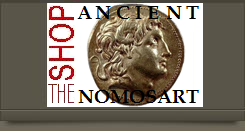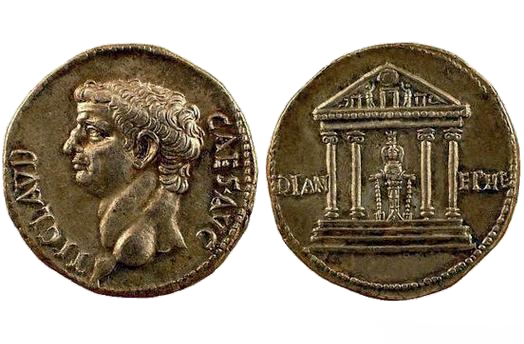
about ancient nomos
Ancient Nomos Art is a museum of galleries exhibiting ancient coins and ancient mint maps. The coin gallery displays the diverse art and history of hand-crafted ancient Greek, Roman, Byzantine, Persian and Medieval coinage. The ancient mints mapping gallery features Greek, Roman, Byzantine, Asia Minor and Medieval mint city regions and territories. Visitor's are welcome to explore, study and enjoy Ancient Nomos Art.

Imperial, Roman – 41 AD
Claudius
From Ancient Galleries

Obverse: A powerful and advanced portrait style of Claudius with bare head.
Reverse: Diana of Ephesia within Ionic tetrastyle temple on four step base; dentiled pediment decorated with Amazons flanking epiphany table, disk above.
LEGEND
Obv: TI CLAVD CAES AVG, Claudius bare head facing left. Rev: DIAN EPHE across field, cult statue of Diana of Ephesus in Ionic temple on four-tiered base; pediment decorated with central epiphany table flanked by Amazon statues; two smaller tables; recumbent statues and disk above.
Emperor Claudius, named Tiberius Claudius Drusus, was born in 10 BC. He was the nephew of Emperor Tiberius and a grandson of Livia Drusilla, the wife of Emperor Augustus. He was also the uncle of the Emperor Caligula. The youthful Claudius was considered less favorable by his imperial relatives because of his less attractive appearance, awkward manner, and vulgar disposition. However, Claudius did become a well educated individual, spending much of his time reading Greek and Roman history, writing many books on the Etruscans and Carthaginians, and pursuing his scholarly interests. The above cistophoric tetradrachm commemorative coin follows shortly after Claudius became emperor and was likely minted as a result of his historical knowledge and Greco-Roman antiquarian interests. The obverse depicts an extremely expressive and powerful portrait style of a mature 50 year old “Augustus Caesar” Claudius facing right. The reverse depicts an unusually complete and exquisite engraving of the Ephesia Temple commemorating Diana of Ephesus. This commemoration of the Temple of Diana Ephesia marked the four-hundredth anniversary of the temples destruction by Hierostratos in 356 BC. Coincidentally, the destruction is thought to have also occurred the same night Alexander the Great was born. Plutarch notes that legends claimed the Ephesus Temple was particularly vulnerable to destruction that night because the goddess Diana was away attending to Alexander’s birth. The coin depicts the Ionic style set on a four step base with the cult-statue of Diana in the center. The temple pediment finely details a central “epiphany” table, flanked by two standing Amazon statues and disk above, flanked again by two smaller tables and two recumbent statuettes. This was a limited issue and rare commemorative.
SPECIAL FEATURE EXHIBIT
The ANAM Special Features gallery takes a closer look at the exquisitely engraved reverse depiction of the Ionic style Ephesia Temple architecture with its finely detailed central “epiphany” table flanked by two standing Amazon statues in the pediment. To view the Special Features coin exhibit commemorating the four-hundredth anniversary of Diana of Ephesus, please use the following link: Claudius Commemorative Ephesia Temple Exhibit
DOCUMENTATION
Value: Cistophorus. Metal: AR Silver. Weight: 11.47 grams. Mint: Ephesus. Date: 41-42 AD.
Attribution: RIC I 118; RPC I 2222; BMCRE 229; BN 299; RSC 30; S. Kreditanstalt 1, 1983, 286.
Legend, Documentation and Attribution
